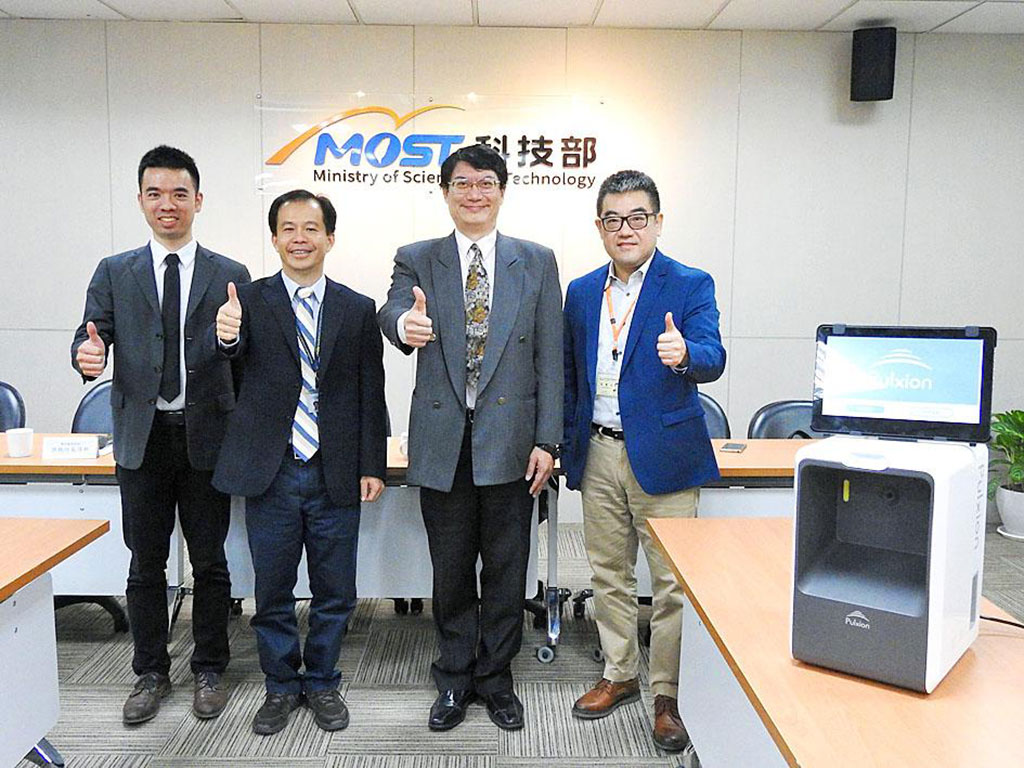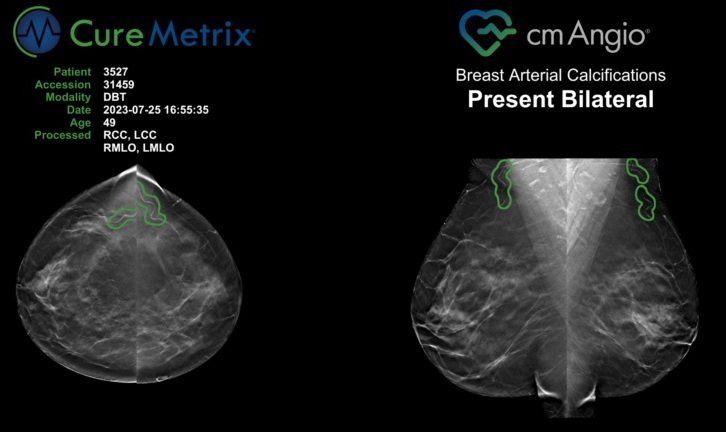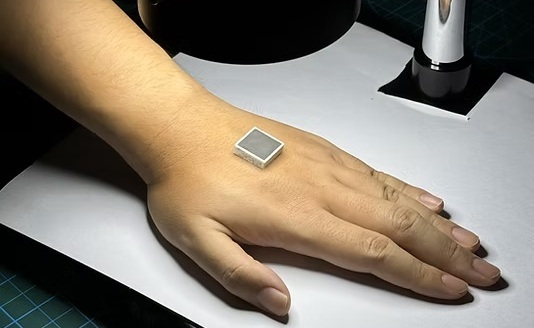Optical Screening System Detects Carotid Artery Stenosis 
|
By MedImaging International staff writers Posted on 25 Jan 2021 |

Image: Pulxion CEO Thomas Hsu (L) and cardiologist Kao Hsien-li (R) with the Pulstroke device (Photo courtesy of Taiwan Ministry of Science and Technology)
A non-invasive, user-friendly, and easy-to-operate assessment tool enables early detection of carotid artery stenosis (CAS), an indicator of stroke.
The Pulxion Medical Technology (Taipei, Taiwan) PulStroke is a digital video device that records a short (20 second) clip of the neck under light emitting diode (LED) light with one simple click. A cloud-based platform uses dynamic video processing, feature extraction, and artificial intelligence (AI) algorithms to analyze the data, delivering the screening results to a smartphone or computer within five minutes. Studies have shown that the accuracy of PulStroke is higher than 90%, when compared to carotid ultrasound.
“The mission of the company is to develop AI-based imaging technology, with the goals of translating the research work into clinical solutions and commercial products,” said Thomas Hsu, CEO of Pulxion. “With this device, Pulxion plans to promote its use at chain pharmacies and clinics, healthcare centers, and local communities for general public who might have stroke issues without foreseeable symptoms. Early detection is the key to the preventive medicine.”
“About 85 percent of strokes are caused by ischemia, or a blockage in an artery that supplies blood to the brain. People with cardiovascular diseases might suffer a stroke without foreseeable symptoms, so early detection is key to prevention,” said cardiologist Kao Hsien-li, MD, of National Taiwan University Hospital (NTUH), who developed the technology. “The degree of stenosis affects the dynamics of blood flow, subtle changes in which are reflected through pulsations that can be detected by image motion analysis.”
Historically, carotid calcification has been detected by x-ray imaging. With the advent of ultrasound Doppler examination of vascular pathology, carotid 2D grey scale has become the routine study for CAS in vascular laboratories.
Related Links:
Pulxion Medical Technology
The Pulxion Medical Technology (Taipei, Taiwan) PulStroke is a digital video device that records a short (20 second) clip of the neck under light emitting diode (LED) light with one simple click. A cloud-based platform uses dynamic video processing, feature extraction, and artificial intelligence (AI) algorithms to analyze the data, delivering the screening results to a smartphone or computer within five minutes. Studies have shown that the accuracy of PulStroke is higher than 90%, when compared to carotid ultrasound.
“The mission of the company is to develop AI-based imaging technology, with the goals of translating the research work into clinical solutions and commercial products,” said Thomas Hsu, CEO of Pulxion. “With this device, Pulxion plans to promote its use at chain pharmacies and clinics, healthcare centers, and local communities for general public who might have stroke issues without foreseeable symptoms. Early detection is the key to the preventive medicine.”
“About 85 percent of strokes are caused by ischemia, or a blockage in an artery that supplies blood to the brain. People with cardiovascular diseases might suffer a stroke without foreseeable symptoms, so early detection is key to prevention,” said cardiologist Kao Hsien-li, MD, of National Taiwan University Hospital (NTUH), who developed the technology. “The degree of stenosis affects the dynamics of blood flow, subtle changes in which are reflected through pulsations that can be detected by image motion analysis.”
Historically, carotid calcification has been detected by x-ray imaging. With the advent of ultrasound Doppler examination of vascular pathology, carotid 2D grey scale has become the routine study for CAS in vascular laboratories.
Related Links:
Pulxion Medical Technology
Latest General/Advanced Imaging News
- AI-Based Tool Accelerates Detection of Kidney Cancer
- New Algorithm Dramatically Speeds Up Stroke Detection Scans
- 3D Scanning Approach Enables Ultra-Precise Brain Surgery
- AI Tool Improves Medical Imaging Process by 90%
- New Ultrasmall, Light-Sensitive Nanoparticles Could Serve as Contrast Agents
- AI Algorithm Accurately Predicts Pancreatic Cancer Metastasis Using Routine CT Images
- Cutting-Edge Angio-CT Solution Offers New Therapeutic Possibilities
- Extending CT Imaging Detects Hidden Blood Clots in Stroke Patients
- Groundbreaking AI Model Accurately Segments Liver Tumors from CT Scans
- New CT-Based Indicator Helps Predict Life-Threatening Postpartum Bleeding Cases
- CT Colonography Beats Stool DNA Testing for Colon Cancer Screening
- First-Of-Its-Kind Wearable Device Offers Revolutionary Alternative to CT Scans
- AI-Based CT Scan Analysis Predicts Early-Stage Kidney Damage Due to Cancer Treatments
- CT-Based Deep Learning-Driven Tool to Enhance Liver Cancer Diagnosis
- AI-Powered Imaging System Improves Lung Cancer Diagnosis
- AI Model Significantly Enhances Low-Dose CT Capabilities
Channels
Radiography
view channel
Routine Mammograms Could Predict Future Cardiovascular Disease in Women
Mammograms are widely used to screen for breast cancer, but they may also contain overlooked clues about cardiovascular health. Calcium deposits in the arteries of the breast signal stiffening blood vessels,... Read more
AI Detects Early Signs of Aging from Chest X-Rays
Chronological age does not always reflect how fast the body is truly aging, and current biological age tests often rely on DNA-based markers that may miss early organ-level decline. Detecting subtle, age-related... Read moreMRI
view channel
Novel Imaging Approach to Improve Treatment for Spinal Cord Injuries
Vascular dysfunction in the spinal cord contributes to multiple neurological conditions, including traumatic injuries and degenerative cervical myelopathy, where reduced blood flow can lead to progressive... Read more
AI-Assisted Model Enhances MRI Heart Scans
A cardiac MRI can reveal critical information about the heart’s function and any abnormalities, but traditional scans take 30 to 90 minutes and often suffer from poor image quality due to patient movement.... Read more
AI Model Outperforms Doctors at Identifying Patients Most At-Risk of Cardiac Arrest
Hypertrophic cardiomyopathy is one of the most common inherited heart conditions and a leading cause of sudden cardiac death in young individuals and athletes. While many patients live normal lives, some... Read moreUltrasound
view channel
Wearable Ultrasound Imaging System to Enable Real-Time Disease Monitoring
Chronic conditions such as hypertension and heart failure require close monitoring, yet today’s ultrasound imaging is largely confined to hospitals and short, episodic scans. This reactive model limits... Read more
Ultrasound Technique Visualizes Deep Blood Vessels in 3D Without Contrast Agents
Producing clear 3D images of deep blood vessels has long been difficult without relying on contrast agents, CT scans, or MRI. Standard ultrasound typically provides only 2D cross-sections, limiting clinicians’... Read moreNuclear Medicine
view channel
PET Imaging of Inflammation Predicts Recovery and Guides Therapy After Heart Attack
Acute myocardial infarction can trigger lasting heart damage, yet clinicians still lack reliable tools to identify which patients will regain function and which may develop heart failure.... Read more
Radiotheranostic Approach Detects, Kills and Reprograms Aggressive Cancers
Aggressive cancers such as osteosarcoma and glioblastoma often resist standard therapies, thrive in hostile tumor environments, and recur despite surgery, radiation, or chemotherapy. These tumors also... Read more
New Imaging Solution Improves Survival for Patients with Recurring Prostate Cancer
Detecting recurrent prostate cancer remains one of the most difficult challenges in oncology, as standard imaging methods such as bone scans and CT scans often fail to accurately locate small or early-stage tumors.... Read moreImaging IT
view channel
New Google Cloud Medical Imaging Suite Makes Imaging Healthcare Data More Accessible
Medical imaging is a critical tool used to diagnose patients, and there are billions of medical images scanned globally each year. Imaging data accounts for about 90% of all healthcare data1 and, until... Read more
Global AI in Medical Diagnostics Market to Be Driven by Demand for Image Recognition in Radiology
The global artificial intelligence (AI) in medical diagnostics market is expanding with early disease detection being one of its key applications and image recognition becoming a compelling consumer proposition... Read moreIndustry News
view channel
GE HealthCare and NVIDIA Collaboration to Reimagine Diagnostic Imaging
GE HealthCare (Chicago, IL, USA) has entered into a collaboration with NVIDIA (Santa Clara, CA, USA), expanding the existing relationship between the two companies to focus on pioneering innovation in... Read more
Patient-Specific 3D-Printed Phantoms Transform CT Imaging
New research has highlighted how anatomically precise, patient-specific 3D-printed phantoms are proving to be scalable, cost-effective, and efficient tools in the development of new CT scan algorithms... Read more
Siemens and Sectra Collaborate on Enhancing Radiology Workflows
Siemens Healthineers (Forchheim, Germany) and Sectra (Linköping, Sweden) have entered into a collaboration aimed at enhancing radiologists' diagnostic capabilities and, in turn, improving patient care... Read more



















